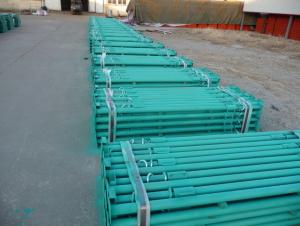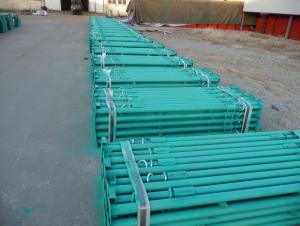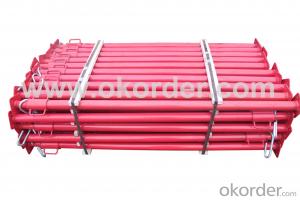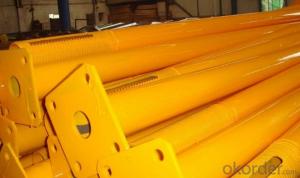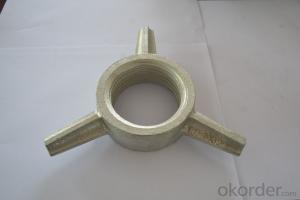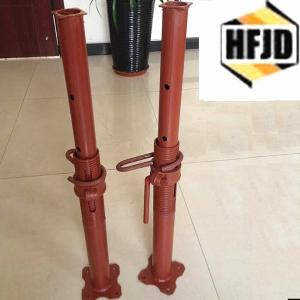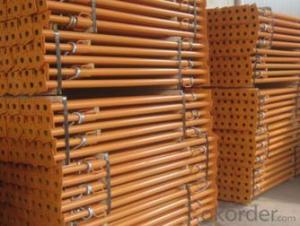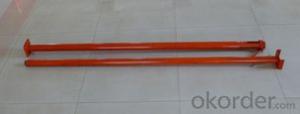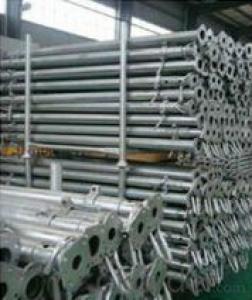Frame Scaffolding System, Folding Scaffolding ,H Frame Scaffolding
- Loading Port:
- China Main Port
- Payment Terms:
- TT or LC
- Min Order Qty:
- 1000 Set/Sets pc
- Supply Capability:
- 10000 pc/month
OKorder Service Pledge
OKorder Financial Service
You Might Also Like
Quick Details
Place of Origin: Tianjin, China (Mainland)
- Model Number: SD1700/1930CGSP
Place of Origin: China (Mainland)
Type: Scaffolding Parts
Scaffolding Part Type: Scaffolding Props
Color: blue/green/red/brown
Height: 1700/1930mm
Steel Pipe Size: 25/42
Coated: Painted;Pre-Galvanized; Electro Galvanized
Material grade: Q195-Q235
Package: Bundles or in Bulk
Certification: ISO9001:2008
Packaging & Delivery
| Packaging Details: | 1- Frame scaffolding system is packed in bundle and wrapped with iron bar . 2- Usually , one 40HQ container can load 300-600 set of props , |
|---|---|
| Delivery Detail: | 40days |
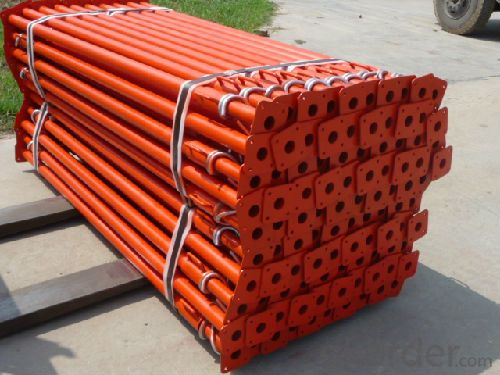

Specifications
Frame scaffolding system is easy to assemble and dismantle which can help to save your time , energy and cost .
Product Description
folding scaffolding
A- An adjustable steel prop including inner tube, Outer tube , prop nut ,prop pin , base plate and top plate
B- Adjustable steel prop can be adjusted to any length within its range which is convenient for using
C- Adjustable steel prop is easy to assemble and dismantle which can help to save your time , energy and cost .
D-We have several kinds of adjustable steel prop which are Middle East type adjustable steel prop , Spanish adjustable steel prop ,and Italian type adjustable steel prop . They are popular in Africa , South America , Middle east etc.
E-Adjustable steel prop is for supporting concrete slab , beam , timber and formwork which is strong and reliable for interior building construction .
F- we can weld the flat plate or the flower plate, or U-head plate , or fork plate at the top of the adjustable steel prop as your request .
folding scaffolding
- Q:Are steel props suitable for supporting temporary stairs or ramps?
- Yes, steel props are suitable for supporting temporary stairs or ramps. Steel props are known for their high load-bearing capacity and stability, making them ideal for providing structural support to temporary structures like stairs and ramps.
- Q:How long can steel props be left in place?
- Steel props can generally be left in place for as long as they are structurally sound and meet the requirements of the specific construction project. However, it is important to regularly inspect and assess the condition of the props to ensure their continued safety and effectiveness.
- Q:What are the different surface treatments available for steel props?
- There are several surface treatments available for steel props, including hot-dip galvanizing, powder coating, and epoxy coating. These treatments help protect the steel from corrosion and extend its lifespan. Hot-dip galvanizing involves immersing the props in a bath of molten zinc, creating a durable corrosion-resistant coating. Powder coating involves applying a dry powder to the surface, which is then baked to form a protective layer. Epoxy coating, on the other hand, involves applying a layer of epoxy paint to the surface, which provides excellent corrosion resistance. Each of these treatments has its own advantages and is selected based on the specific requirements and environmental conditions.
- Q:Are steel props suitable for both indoor and outdoor applications?
- Yes, steel props are suitable for both indoor and outdoor applications. Steel props, also known as adjustable steel props or steel shoring props, are versatile support systems used in construction and renovation projects to provide temporary support to ceilings, walls, and other structures. The durability and strength of steel make it a suitable material for outdoor applications, as it can withstand harsh weather conditions such as rain, wind, and extreme temperatures. Steel props are often galvanized or coated to protect against corrosion, further enhancing their suitability for outdoor use. Indoor applications also benefit from the use of steel props. They are commonly used in residential and commercial projects to support ceilings during repair or installation, provide temporary support during construction work, or to reinforce weak or damaged walls. Steel props are adjustable in height, allowing for flexibility and adaptability in various indoor and outdoor scenarios. They can be easily extended or retracted to fit different ceiling or wall heights, making them suitable for a wide range of projects. In summary, steel props are a reliable and versatile solution for both indoor and outdoor applications. Their strength, durability, and adjustability make them suitable for supporting structures in various construction and renovation projects, regardless of the location or environmental conditions.
- Q:How do you prevent damage to steel props during construction activities?
- There are several measures that can be taken to prevent damage to steel props during construction activities. Firstly, ensuring proper training and supervision of workers is crucial, as they need to handle the props correctly and with care. Secondly, using protective measures such as placing rubber caps on the ends of the props can help prevent scratches and dents. Additionally, regular inspections should be conducted to identify any signs of wear or damage, and prompt maintenance or replacement should be carried out when necessary. Lastly, proper storage and transportation of the props, using appropriate equipment and techniques, can also help prevent damage during construction activities.
- Q:What are the common accessories available for steel props?
- Some common accessories available for steel props include adjustable base plates, top plates, prop pins, prop sleeves, prop nuts, and prop brackets. These accessories help enhance the stability, adjustability, and overall performance of steel props in construction and temporary shoring applications.
- Q:How do you adjust the height of a steel prop?
- To adjust the height of a steel prop, you need to follow a systematic process. Here are the steps to adjust the height of a steel prop: 1. Inspect the prop: Before adjusting the height, ensure that the steel prop is in good condition and not damaged. Check for any cracks, bends, or defects that may affect its stability. 2. Determine the required height: Measure the distance between the ground or supporting surface and the desired height for the prop. This will help you determine how much adjustment is needed. 3. Loosen the locking mechanism: Most steel props have a locking mechanism, usually a pin or a collar, to secure the height adjustment. Locate this mechanism and loosen it to allow movement of the prop. 4. Adjust the height: Depending on the type of steel prop, there are different ways to adjust the height. If it is a telescopic prop, you can extend or retract the sections to achieve the desired height. For a screw-type prop, rotate the threaded rod clockwise or counterclockwise to raise or lower the prop respectively. 5. Secure the adjusted height: Once you have set the correct height, tighten the locking mechanism to secure the prop in place. Ensure that it is firmly locked to prevent any accidental movement. 6. Test stability: After adjusting the height, check the stability of the prop by applying some weight or pressure on it. Ensure that it remains steady and does not wobble or shift. If there are any stability issues, reassess the height adjustment and make necessary corrections. Remember to exercise caution and follow the manufacturer's guidelines when adjusting steel props. If you are unsure or inexperienced, it is advisable to seek assistance from a professional or someone with expertise in using steel props.
- Q:What are the common safety guidelines for working with steel props?
- When working with steel props, it is important to follow certain safety guidelines to ensure a safe working environment. Here are some common safety guidelines for working with steel props: 1. Inspect the Props: Before using steel props, thoroughly inspect them for any signs of damage, such as cracks, bends, or rust. Do not use damaged props as they may fail under load. 2. Proper Handling: When handling steel props, use proper lifting techniques and ensure you have a firm grip. Avoid dragging or dropping them, as this can cause damage and compromise their structural integrity. 3. Load Capacity: Understand the load capacity of the steel props and ensure that they are not overloaded. Exceeding the load capacity can lead to structural failure and accidents. 4. Secure Placement: Place the props on stable and level ground to prevent them from sinking or tipping. Use appropriate base plates or sole plates to distribute the load and provide stability. 5. Stability Checks: Regularly check the stability of the steel props during use. Ensure they are securely braced and that there is no excessive movement or swaying. If stability is compromised, adjust or reinforce the props as necessary. 6. Proper Positioning: Position the steel props directly under the load to ensure even distribution of weight. Avoid placing them at an angle, as this can cause them to buckle or fail. 7. Height Adjustments: When adjusting the height of the props, follow the manufacturer's instructions and use the provided locking mechanisms to secure them in place. Ensure that the props are fully extended and locked before loading them. 8. Personal Protective Equipment (PPE): Wear appropriate PPE, such as gloves, safety glasses, and steel-toed boots, when working with steel props. This will protect you from potential injuries caused by sharp edges, falling objects, or accidental impacts. 9. Communication and Warning Signs: Clearly communicate with other workers in the vicinity about the presence of steel props and any potential hazards. Use warning signs or barricades to alert others and prevent accidental collisions or tripping. 10. Training and Competency: Ensure that workers who are responsible for working with steel props have received proper training on their safe use. Workers should be competent in understanding load calculations, proper installation procedures, and how to identify and address potential hazards. By following these common safety guidelines, you can minimize the risk of accidents and injuries when working with steel props. It is always important to prioritize safety and adhere to the specific safety protocols established by your organization and relevant regulatory authorities.
- Q:What are the common sizes or dimensions of steel props?
- The dimensions and sizes of steel props can differ based on the specific needs of a construction project. However, the industry commonly utilizes the following sizes: 1. Length: Steel props come in various lengths, typically ranging from 1.8 meters (6 feet) to 5.5 meters (18 feet). These lengths can be easily adjusted or extended using additional components. 2. Diameter: Steel props usually have a diameter ranging from 40mm to 48mm (1.5 to 2 inches). This ensures the necessary strength and stability to support heavy loads. 3. Load-bearing capacity: Steel props are designed to support different loads, and their load-bearing capacity can vary. Common load capacities for steel props can range from 20kN (kilonewtons) to 60kN, depending on the specific application and construction requirements. 4. Adjustable height: The adjustable height feature is one of the main advantages of steel props. The extendable prop system allows for easy adjustment and adaptation to various heights. The adjustable range typically varies from 1.2 meters (4 feet) to 3.5 meters (11.5 feet). It is essential to note that these dimensions and sizes are not fixed and may differ based on the manufacturer, project requirements, and local building regulations. It is recommended to consult with a structural engineer or construction professional to determine the most suitable steel prop dimensions for a specific project.
- Q:How do you prevent steel props from sinking in clay soil?
- To prevent steel props from sinking in clay soil, there are several measures you can take: 1. Use larger and wider steel props: Increasing the surface area of the steel props can distribute the weight more evenly, reducing the chances of sinking. Consider using props with larger diameter tubes or wider base plates. 2. Increase the number of props: By adding more steel props, you can distribute the load across a larger area, minimizing the pressure on each individual prop and reducing the risk of sinking. 3. Install steel props deeper: Digging a deeper hole for the steel props can provide a more stable foundation, reaching below the clay layer and into more stable soil or rock. This can help prevent sinking by providing a stronger support system. 4. Use concrete footings: Pouring concrete footings or foundations under the steel props can provide additional stability. The concrete footings can help distribute the load more evenly and prevent sinking in clay soil. 5. Add a layer of gravel or crushed stone: Placing a layer of gravel or crushed stone underneath the steel props can improve drainage and reduce the chances of sinking. This layer can act as a stable base and prevent the clay soil from becoming too saturated with water. 6. Implement ground improvement techniques: In cases where the clay soil is particularly unstable, ground improvement techniques can be employed. These techniques include methods such as soil stabilization, compaction, or the use of geosynthetic materials to improve the load-bearing capacity of the soil. It is important to note that these measures should be evaluated based on site-specific conditions and engineering recommendations. Consulting with a geotechnical engineer or a structural engineer can provide valuable insights and guidance to ensure the stability and safety of steel props in clay soil.
1. Manufacturer Overview |
|
|---|---|
| Location | |
| Year Established | |
| Annual Output Value | |
| Main Markets | |
| Company Certifications | |
2. Manufacturer Certificates |
|
|---|---|
| a) Certification Name | |
| Range | |
| Reference | |
| Validity Period | |
3. Manufacturer Capability |
|
|---|---|
| a)Trade Capacity | |
| Nearest Port | |
| Export Percentage | |
| No.of Employees in Trade Department | |
| Language Spoken: | |
| b)Factory Information | |
| Factory Size: | |
| No. of Production Lines | |
| Contract Manufacturing | |
| Product Price Range | |
Send your message to us
Frame Scaffolding System, Folding Scaffolding ,H Frame Scaffolding
- Loading Port:
- China Main Port
- Payment Terms:
- TT or LC
- Min Order Qty:
- 1000 Set/Sets pc
- Supply Capability:
- 10000 pc/month
OKorder Service Pledge
OKorder Financial Service
Similar products
New products
Hot products
Hot Searches
